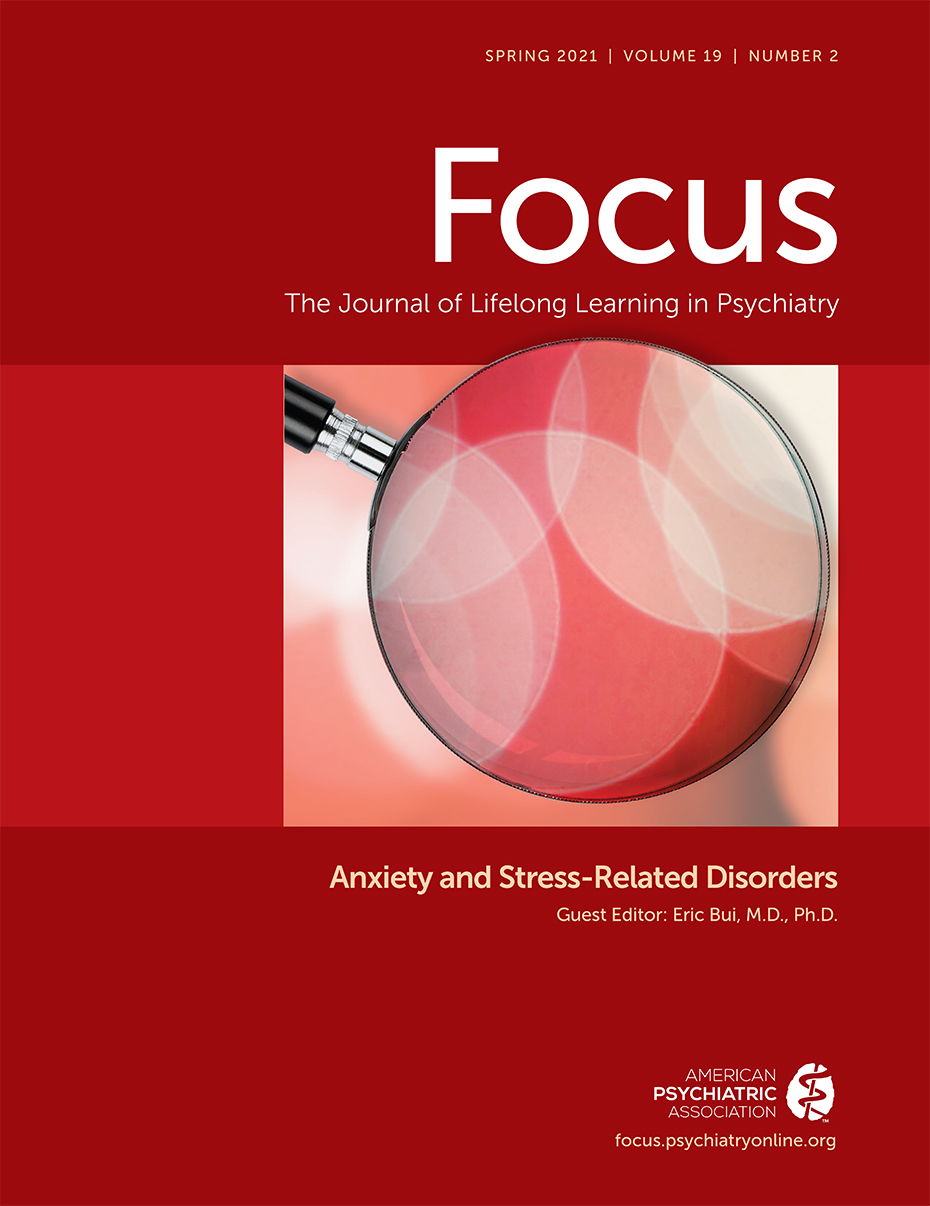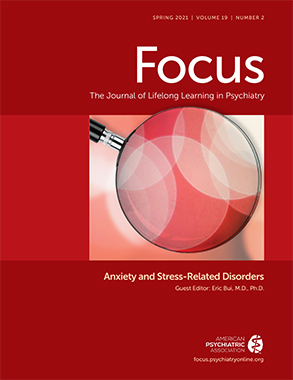Serving as guest editor for this issue of Focus on anxiety and stress-related disorders was an absolute pleasure and a privilege. I am delighted to bring to you this collection of papers on a range of topics that I believe are clinically meaningful and most timely!
First, three articles provide an overview of state-of-the-art treatment approaches for anxiety and stress-related conditions, including cognitive-behavioral treatments and pharmacological treatments for anxiety disorders, as well as cross-cultural approaches to traumatic stress. Second, two reviews specifically provided insight on two emerging topics. I believe that the review focused on prolonged grief disorder will be particularly of interest to psychiatrists and other providers, given that this condition is slated to be included in the forthcoming revision of the DSM. Similarly, the review on the evidence base for mind-body programs will be helpful to support the readers’ clinical practice, as those approaches have been the focus of increasing clinical and research interest in recent years. Third, two articles reviewed how cutting-edge psychological research (network science) and pharmacological research (psychedelics) could be leveraged in the future to support innovative treatment approaches for anxiety and stress-related conditions.
Despite tremendous advances in our field since 1836, when Williams first described a panic attack, this collection also highlights three major gaps: the virtual absence of pharmacotherapeutic innovations in the past 30 years, the difficulty to widely provide access to evidence-based treatments to those who need them, and the current disorder-centered approach that prevents personalized treatments. A stepped-care approach—i.e., a strategy to deliver and monitor treatments so that the most effective, yet least resource intensive, treatment is delivered first, only “stepping up” to more resource-using treatments as required by the level of individual patient need—is yet to be developed and widely implemented for anxiety and stress-related disorders.
Recent advances in the field of information and communication technologies might be leveraged to develop such a stepped care model. Advances in mobile technologies have recently promoted the development of “digital phenotyping,” defined as “moment-by-moment quantification of the individual-level human phenotype in situ using data from personal digital devices,” including smartphones and smartwatches. Because symptoms often manifest as behaviors (e.g., avoidance, insomnia, hyperarousal, retardation), they can be mapped to digital phenotypes. Passively and actively collected data could therefore be used to detect early emerging symptoms that precede the onset of full-blown psychiatric symptoms and that could be targeted by tailored interventions delivered just in time. The emergence of artificial intelligence (AI) has enabled automated analytics of large amounts of data that could be leveraged to establish individual digital phenotypes (modeling clinical symptoms); predict, using those digital phenotypes, the development of psychiatric conditions; and deliver adaptive interventions in a stepped care fashion that will maximize efficiency for the patient and the health care system. This would be particularly relevant for individuals at high risk of developing a range of anxiety and stress-related conditions, such as those exposed to a major stressor like a traumatic event of bereavement.
One (imaginary) example of a successful implementation of such an approach could be the case of Paul, a 37-year-old man admitted to the hospital after an accident a few years from now. Other than bruising, he has no physical injury. He is, however, shaken and expresses intense fear about the event. Before discharging Paul, the physician discusses referrals, including a follow-up appointment with a psychotherapist in two months and the downloading of an AI-based prevention mobile app. Upon installation of the app, Paul gives permission to access the available real-world data sources (i.e., historic and current data from mobile and wearable device sensors) and service providers (social media account). The app will then instruct Paul to calibrate his personal symptoms by completing ecological momentary assessments (EMAs), over the following three days. Available historic and current digital data along with EMA data will allow the digital phenotyping of Paul’s symptoms. This allows the app to passively monitor symptoms based on smartphone usage, texting, voice, heart rate, geolocalization, and actigraphy data (smartwatch); social media activity, and to provide personalized recommendations. The app then models Paul’s network of symptoms, including emotional numbness and social isolation (changes in social media and texting activity), avoidance of situations (geolocalization data), and sleep problems (smartphone, and actigraphy data), and identifies sleep problems or avoidance of situations as the most central symptoms. The app then provides Paul with a mobile version of a sleep intervention. After 10 days, Paul’s sleep is much improved, which in turn helps his concentration at work, lifts his mood, and destabilizes the entire symptom network. Four weeks after the accident, the app sends a report to Paul on his symptoms, which are minimally present, and asks him whether he would like to keep the follow-up appointment with the psychotherapist. Paul decides he is doing fine and does not need to see the therapist but wants to continue tracking his symptoms to prevent relapses. The app then sends an e-mail alert to the emergency physician to share the symptom profile and to the psychotherapist to cancel the appointment. While this clinical vignette belongs to science fiction today, it gives us an idea of the potential of using new technologies to improve health care efficiency, reduce health care costs, and provide universal access to care. The future will tell us whether such a vision can be accomplished!
Finally, I would like to end this message by thanking my friends and colleagues who contributed to this issue, many of whom have supported me professionally and personally throughout the years at the Massachusetts General Hospital. This compendium was prepared during the first two waves of the COVID-19 pandemic, and I feel all the more indebted to these individuals for their outstanding contributions during extremely demanding times. I hope readers will find this special issue a valuable resource that will help in day-to-day practice when caring for patients with anxiety and stress-related conditions.

